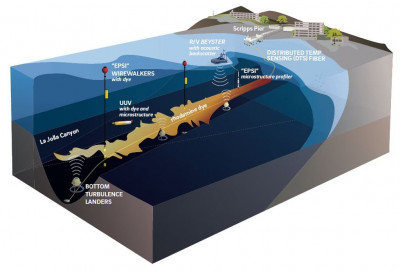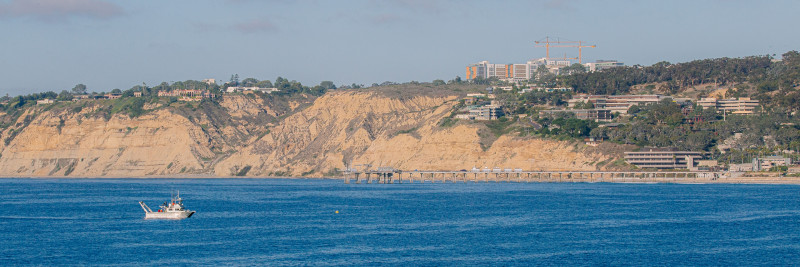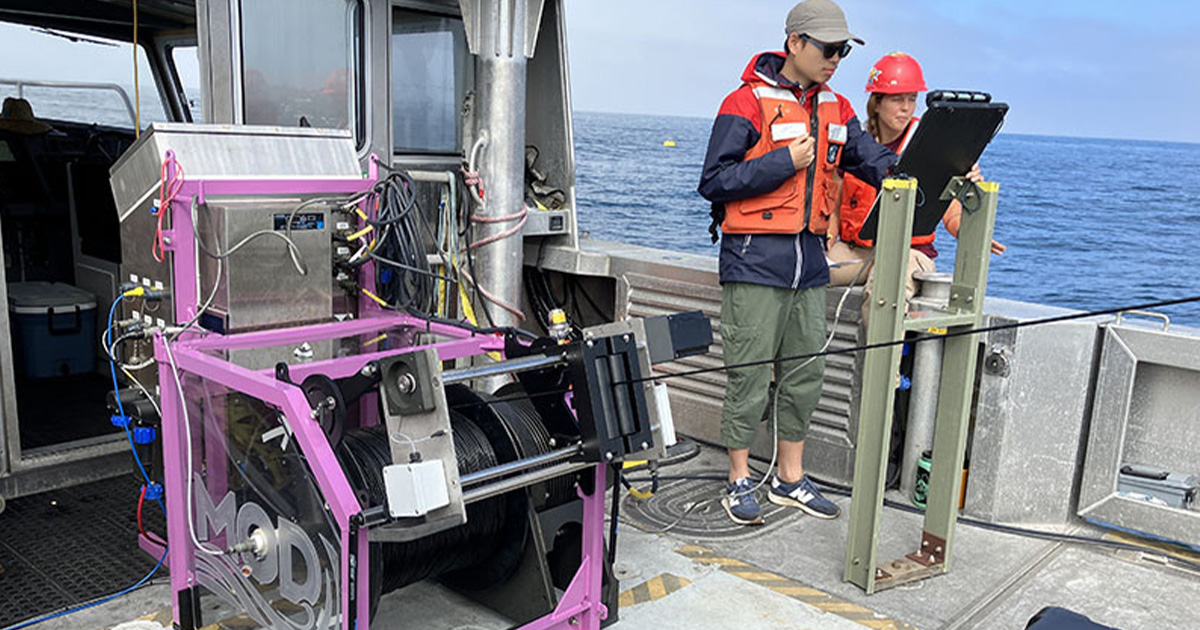If you’ve ever noticed the abundance of marine life teeming in waters off La Jolla, California, you’re not alone. Recently, scientists at Scripps Institution of Oceanography at UC San Diego have been probing the depths of their local “front yard” to better understand the underwater dynamics and upwelling that contribute to this flourishing marine ecosystem.
The research effort—known as the Turbulence in the La Jolla Canyon Project—is spearheaded by the Multiscale Ocean Dynamics (MOD) group at Scripps Oceanography, with funding provided by the Office of Naval Research (ONR). During the week-long pilot study launched this October, several MOD team members used Scripps coastal research vessel Bob and Betty Beyster to deploy sophisticated ocean instruments and release an environmentally-safe pink dye into the submerged La Jolla Canyon, gaining critical insights on ocean turbulence.
Scripps physical oceanographer Matthew Alford, a co-founder of the MOD group and principal investigator of the project, emphasized the importance of the experiment. He said the pilot study is already providing fundamental insights into fluid mechanics and the workings of the ocean, which is knowledge that can inform climate models.
"We were completely amazed, frankly, by the vigor and complexity of the turbulence, and it’s amazing that this dynamic underwater system exists right here in front of Scripps Institution of Oceanography,” said Alford. “Despite decades of study, there's been limited exploration of ocean physics within the La Jolla Canyon. It’s an enigmatic system that we're still unraveling, and this project is helping us solve that mystery.”
The use of the pink dye (Rhodamine WT)—which is non-toxic and has been approved by the Environmental Protection Agency—is a pivotal component of this research. Released along the seafloor at a depth of 85 meters (279 feet), the dye served as a marker, enabling the tracking of water flow and underwater turbulence as it moved through the stratified boundaries of a steep submarine canyon.
 A schematic by the MOD team showing the La Jolla Canyon, the dye release in the bottom boundary layer, and the suite of observational tools. (Image credit: SCRIPPS)
A schematic by the MOD team showing the La Jolla Canyon, the dye release in the bottom boundary layer, and the suite of observational tools. (Image credit: SCRIPPS)
Throughout the week, the MOD team followed the dye’s movement and collected vital data using instruments including an ocean-wave-powered vertical profiling system known as the Wirewalker, acoustic recorders, and a custom instrument developed by MOD known as the fast CTD, which measures conductivity and temperature at various depths up to ten times more densely than conventional CTD rosettes.
“Using the pink dye plus these very fast profiling instruments and vehicles has been a really powerful combination,” said Alford. “We introduced the dye around noon, and by 2:30 p.m., we were amazed at how the turbulence had already complicated the shape of this cloud of dye. That was surprising and exciting.”
Earlier this year, the same type of pink dye was used successfully in a different Scripps-led oceanographic experiment, Plumes in Nearshore Conditions, or PiNC, which made international headlines when the waves along Torrey Pines State Beach turned bright pink. The MOD team noted that the dye used in their turbulence study is not visible at the surface due to its release occurring much deeper and farther offshore compared to the PiNC experiment.
 R/V Bob and Betty Beyster shown just off the coast of La Jolla, with the Scripps Oceanography campus and the iconic Scripps Pier shown in the background. (Image credit: San Nguyen/SCRIPPS)
R/V Bob and Betty Beyster shown just off the coast of La Jolla, with the Scripps Oceanography campus and the iconic Scripps Pier shown in the background. (Image credit: San Nguyen/SCRIPPS)
Now that Alford and his team are back in the lab, they’re working on processing and analyzing all the data that was collected. More extensive research expeditions to investigate turbulence in the La Jolla Canyon are planned for the spring of 2024.



